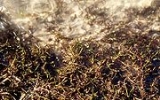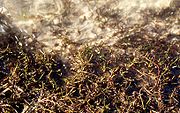
Littorella
Encyclopedia
Littorella is a genus of two to three species of aquatic plants. Many plants live their entire lives submersed, and reproduce by stolon
s, but some are only underwater for part of the year, and flower when they are not underwater.
. Thus, cladistics would allow it to be considered either as a separate genus or as part of Plantago. Some researchers, particularly Rahn in the 1990s, have considered Littorella to be located within Plantago, but this does not seem to be required given the molecular data and a closer look at morphology.

Some authors have treated L. uniflora and L. americana to be one species, but molecular data show L. americana to be more closely related to L. australis than it is to L. uniflora, which argues for recognizing three species. Other considerations, such as the wider range and more frequent flowering of L. uniflora, also argue for separate species. It seems likely that the genus originated in Europe and first spread to North America, and from there to South America, with both events happening in the Pleistocene
or later.
to Mediterranean
. The North and South American species are found in a more limited range of temperate
climates.
Stolon
In biology, stolons are horizontal connections between organisms. They may be part of the organism, or of its skeleton; typically, animal stolons are external skeletons.-In botany:...
s, but some are only underwater for part of the year, and flower when they are not underwater.
Classification
Molecular data show Littorella to be sister to the rest of the genus PlantagoPlantago
Plantago is a genus of about 200 species of small, inconspicuous plants commonly called plantains. They share this name with the very dissimilar plantain, a kind of banana. Most are herbaceous plants, though a few are subshrubs growing to 60 cm tall. The leaves are sessile, but have a narrow...
. Thus, cladistics would allow it to be considered either as a separate genus or as part of Plantago. Some researchers, particularly Rahn in the 1990s, have considered Littorella to be located within Plantago, but this does not seem to be required given the molecular data and a closer look at morphology.
Species

- Littorella uniflora. Found in Europe from IcelandIcelandIceland , described as the Republic of Iceland, is a Nordic and European island country in the North Atlantic Ocean, on the Mid-Atlantic Ridge. Iceland also refers to the main island of the country, which contains almost all the population and almost all the land area. The country has a population...
to the black seaBlack SeaThe Black Sea is bounded by Europe, Anatolia and the Caucasus and is ultimately connected to the Atlantic Ocean via the Mediterranean and the Aegean seas and various straits. The Bosphorus strait connects it to the Sea of Marmara, and the strait of the Dardanelles connects that sea to the Aegean...
. - Littorella americana from northern North AmericaNorth AmericaNorth America is a continent wholly within the Northern Hemisphere and almost wholly within the Western Hemisphere. It is also considered a northern subcontinent of the Americas...
. - Littorella australis from patagoniaPatagoniaPatagonia is a region located in Argentina and Chile, integrating the southernmost section of the Andes mountains to the southwest towards the Pacific ocean and from the east of the cordillera to the valleys it follows south through Colorado River towards Carmen de Patagones in the Atlantic Ocean...
, in southern ChileChileChile ,officially the Republic of Chile , is a country in South America occupying a long, narrow coastal strip between the Andes mountains to the east and the Pacific Ocean to the west. It borders Peru to the north, Bolivia to the northeast, Argentina to the east, and the Drake Passage in the far...
and ArgentinaArgentinaArgentina , officially the Argentine Republic , is the second largest country in South America by land area, after Brazil. It is constituted as a federation of 23 provinces and an autonomous city, Buenos Aires...
, and the Falkland IslandsFalkland IslandsThe Falkland Islands are an archipelago in the South Atlantic Ocean, located about from the coast of mainland South America. The archipelago consists of East Falkland, West Falkland and 776 lesser islands. The capital, Stanley, is on East Falkland...
Some authors have treated L. uniflora and L. americana to be one species, but molecular data show L. americana to be more closely related to L. australis than it is to L. uniflora, which argues for recognizing three species. Other considerations, such as the wider range and more frequent flowering of L. uniflora, also argue for separate species. It seems likely that the genus originated in Europe and first spread to North America, and from there to South America, with both events happening in the Pleistocene
Pleistocene
The Pleistocene is the epoch from 2,588,000 to 11,700 years BP that spans the world's recent period of repeated glaciations. The name pleistocene is derived from the Greek and ....
or later.
Distribution
The European species is found in a wide range of habitats, from arcticArctic
The Arctic is a region located at the northern-most part of the Earth. The Arctic consists of the Arctic Ocean and parts of Canada, Russia, Greenland, the United States, Norway, Sweden, Finland, and Iceland. The Arctic region consists of a vast, ice-covered ocean, surrounded by treeless permafrost...
to Mediterranean
Mediterranean climate
A Mediterranean climate is the climate typical of most of the lands in the Mediterranean Basin, and is a particular variety of subtropical climate...
. The North and South American species are found in a more limited range of temperate
Temperate
In geography, temperate or tepid latitudes of the globe lie between the tropics and the polar circles. The changes in these regions between summer and winter are generally relatively moderate, rather than extreme hot or cold...
climates.

